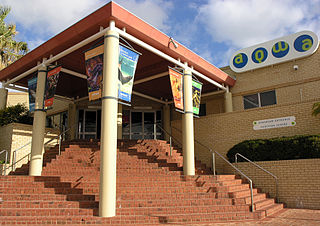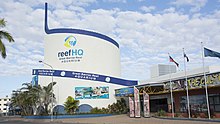
The Great Barrier Reef is the world's largest coral reef system, composed of over 2,900 individual reefs and 900 islands stretching for over 2,300 kilometres (1,400 mi) over an area of approximately 344,400 square kilometres (133,000 sq mi). The reef is located in the Coral Sea, off the coast of Queensland, Australia, separated from the coast by a channel 100 miles wide in places and over 200 feet deep. The Great Barrier Reef can be seen from outer space and is the world's biggest single structure made by living organisms. This reef structure is composed of and built by billions of tiny organisms, known as coral polyps. It supports a wide diversity of life and was selected as a World Heritage Site in 1981. CNN labelled it one of the Seven Natural Wonders of the World in 1997. Australian World Heritage places included it in its list in 2007. The Queensland National Trust named it a state icon of Queensland in 2006.

The Great Barrier Reef Marine Park protects a large part of Australia's Great Barrier Reef from damaging activities. It is a vast multiple-use Marine Park which supports a wide range of uses, including commercial marine tourism, fishing, ports and shipping, recreation, scientific research and Indigenous traditional use. Fishing and the removal of artefacts or wildlife is strictly regulated, and commercial shipping traffic must stick to certain specific defined shipping routes that avoid the most sensitive areas of the park. The Great Barrier Reef is the largest and best known coral reef ecosystem in the world. Its reefs, almost 3000 in total, represent about 10 per cent of all the coral reef areas in the world. It supports an amazing variety of biodiversity, providing a home to thousands of coral and other invertebrate species, bony fish, sharks, rays, marine mammals, marine turtles, sea snakes, as well as algae and other marine plants.
Halifax Bay Wetlands is a national park at Halifax Bay in Queensland, Australia, 1179 km northwest of Brisbane.

The Coral Sea is a marginal sea of the South Pacific off the northeast coast of Australia, and classified as an interim Australian bioregion. The Coral Sea extends 2,000 kilometres (1,200 mi) down the Australian northeast coast. Most of it is protected by the French Natural Park of the Coral Sea and the Australian Coral Sea Marine Park. The sea was the location for the Battle of the Coral Sea, a major confrontation during World War II between the navies of the Empire of Japan, and the United States and Australia.

The New England Aquarium is a nonprofit organization located in Boston, Massachusetts. The species exhibited include harbor and northern fur seals, California sea lions, African and southern rockhopper penguins, giant Pacific octopuses, weedy seadragons, and thousands of saltwater and freshwater fishes. In addition to the main aquarium building, attractions at Central Wharf include the Simons Theatre and the New England Aquarium Whale Watch. More than 1.3 million guests visited the aquarium each year prior to the outbreak of the COVID-19 pandemic.

Sea Life Sunshine Coast at Mooloolaba, Sunshine Coast, Queensland, Australia is a marine mammal park, oceanarium and wildlife sanctuary. Sea Life Sunshine Coast is an institutional member of the Zoo and Aquarium Association (ZAA). The attraction is a Sea Life Centre owned by Merlin Entertainments, and is globally referred to as Sea Life Sunshine Coast by the firm. It was formerly known as UnderWater World.

The Aquarium of Western Australia (AQWA) is a privately owned aquarium in Hillarys, Western Australia. AQWA was Australia's largest aquarium when it opened and still possesses Australia's largest single aquarium and walk-through underwater tunnel.
Barber Island is a tiny island just south of Great Palm Island, part of the Palm Islands group in Queensland, Australia. The Aboriginal name for this island is Boodthean. Barber Island is one of the ten islands in the local government area of the Palm Island Aboriginal Shire Council.

SEA LIFE Sydney Aquarium is a public aquarium that features a large variety of Australian aquatic life, displaying more than 700 species comprising more than 13,000 individual fish and other sea and water creatures from most of Australia's water habitats. Opened in 1988, it is regarded as one of Sydney's premier tourist attractions with over 55% of its visitors each year coming from overseas.
The Australian Marine Conservation Society (AMCS) is an Australian environmental not-for-profit organisation. It was founded in 1965 as the Queensland Littoral Society before changing its name to the Australian Littoral Society and then finally in 1995 to its current title. It works on protecting the health and vitality of Australia's coasts and oceans.

Flinders Reef is a small isolated reef near Moreton Island, 5 kilometres (3 mi) north-east of Cape Moreton in South East Queensland, Australia. It has the highest number of coral species of any subtropical reef system along Australia's east coast and is the nearest true coral reef to Brisbane. Flinders Reef is one of South East Queensland's most popular dive sites. The reef is located within the Moreton Bay Marine Park and is monitored by the Reef Check conservation program. The reef is located within the Tweed–Moreton marine biogeographic region.

The Great Barrier Reef is the world's largest reef systems, stretching along the East coast of Australia from the northern tip down at Cape York to the town of Bundaberg, is composed of roughly 2,900 individual reefs and 940 islands and cays that stretch for 2,300 kilometres (1,616 mi) and cover an area of approximately 344,400 square kilometres (133,000 sq mi). The reef is located in the Coral Sea, off the coast of Queensland in northeast Australia. A large part of the reef is protected by the Great Barrier Reef Marine Park.

The National Museum of Marine Biology and Aquarium is the most notable museum and research institution for marine biology in Taiwan, which located in Checheng Township, Pingtung County, Taiwan.
Pandora Reef is a low-lying island in addition to being an adjacent fringing reef. It is in Halifax Bay in Queensland, Australia. It is 13 kilometres (8.1 mi) from the Greater Palm group. The name Pandora Reef dates back to at least 1889.
Albino Rock, formerly White Rock, is an islet east of Great Palm Island, part of the Greater Palm group in Queensland, Australia. The island is in the Hinchinbrook jurisdiction, and is part of Orpheus Island National Park.
St. Crispin's Reef is an elongate outer-shelf coral reef in the Great Barrier Reef, Queensland, Australia.

Tourism is one of the major industries in the Great Barrier Reef region. Approximately five million people visit the Great Barrier Reef each year. According to the WWF, tourism of the area contributes $5.4 billion a year to the Australian economy, and employs approximately 69,000 people. Ove Hoegh-Guldberg sees the key competitive advantage of the Great Barrier Reef as opposed to other, closer, reef tourism destinations is the region's reputation as being "the most pristine coral reef on the planet". The GBRMPA states that careful management, which includes permits for camping and all commercial marine tourism within the Great Barrier Reef Marine Park, has so far ensured that tourists have a very minimal impact on the reef.

Eilat's Coral World Underwater Observatory is a public aquarium, park and conservation center located in Eilat, Israel. It is the biggest public aquarium in Israel, and it hosts over 800 species. It was founded in 1974 and was the first of its kind. The park and aquarium is located to the south of Eilat's Coral Beach nature reserve.
The Coral Sea Marine Park is an Australian marine park located in the Coral Sea off the coast of Queensland. The marine park covers an area of 989,836 km2 (382,178 sq mi) and is assigned IUCN category IV. It is Australia's largest single marine park and together with the French Natural Park of the Coral Sea form the largest protected area in the World.















